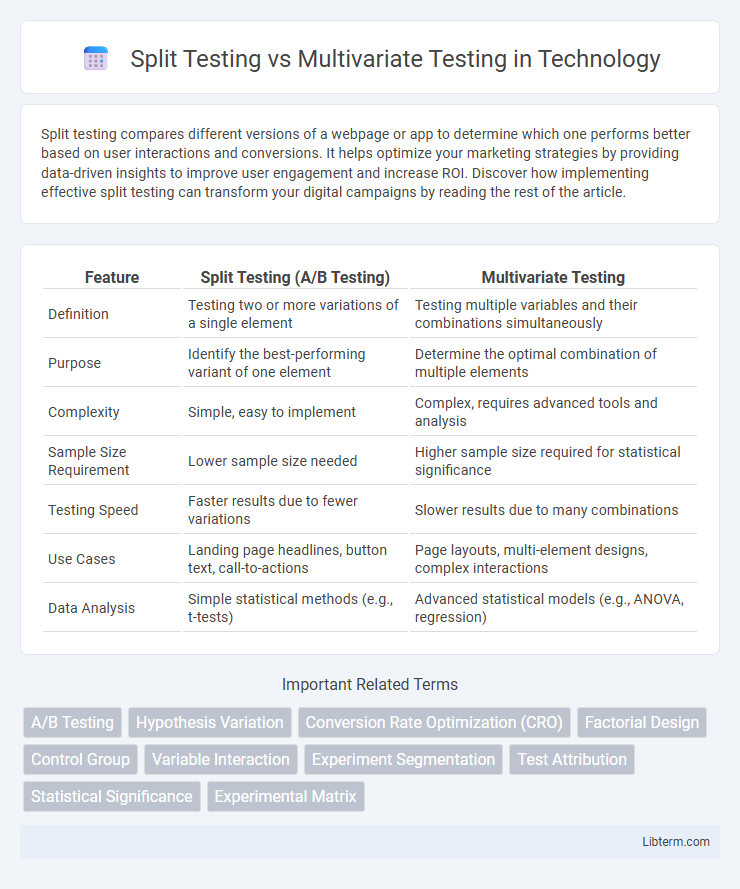Split testing compares different versions of a webpage or app to determine which one performs better based on user interactions and conversions. It helps optimize your marketing strategies by providing data-driven insights to improve user engagement and increase ROI. Discover how implementing effective split testing can transform your digital campaigns by reading the rest of the article.
Table of Comparison
| Feature | Split Testing (A/B Testing) | Multivariate Testing |
|---|---|---|
| Definition | Testing two or more variations of a single element | Testing multiple variables and their combinations simultaneously |
| Purpose | Identify the best-performing variant of one element | Determine the optimal combination of multiple elements |
| Complexity | Simple, easy to implement | Complex, requires advanced tools and analysis |
| Sample Size Requirement | Lower sample size needed | Higher sample size required for statistical significance |
| Testing Speed | Faster results due to fewer variations | Slower results due to many combinations |
| Use Cases | Landing page headlines, button text, call-to-actions | Page layouts, multi-element designs, complex interactions |
| Data Analysis | Simple statistical methods (e.g., t-tests) | Advanced statistical models (e.g., ANOVA, regression) |
Understanding Split Testing: The Basics
Split testing, also known as A/B testing, involves comparing two variations of a single element to determine which performs better in achieving a specific goal, such as increasing conversion rates or click-through rates. This method isolates one variable at a time, making it easier to attribute changes in user behavior directly to the tested variation. Split testing is ideal for optimizing website elements, email campaigns, and marketing strategies by providing clear, data-driven insights.
What Is Multivariate Testing?
Multivariate testing is a method used to evaluate multiple variables within a web page simultaneously to determine the optimal combination that maximizes user engagement and conversion rates. Unlike split testing, which compares two or more distinct versions of a single element, multivariate testing analyzes various combinations of multiple page elements such as headlines, images, and call-to-action buttons. This approach provides granular insights into how different design components interact and influence visitor behavior, enabling data-driven optimization for better performance.
Key Differences Between Split Testing and Multivariate Testing
Split testing evaluates the performance of two or more distinct versions of a single variable to identify the best performer, while multivariate testing simultaneously examines multiple variables and their combinations to determine the most effective elements. Split testing offers clearer insights into user preferences by isolating changes one at a time, whereas multivariate testing provides detailed interaction analysis between different variables but requires significantly more traffic for statistical validity. Businesses typically choose split testing for simpler, straightforward experiments and multivariate testing when optimizing complex page designs with multiple components.
When to Use Split Testing
Split testing is ideal when comparing two distinct variations to determine which one performs better in a controlled environment, especially for testing major changes like different landing pages or email subject lines. It provides clear, statistically significant results quickly, making it suitable for campaigns with high traffic where simple, impactful decisions are needed. Use split testing when you want to isolate one or two key variables to directly measure their effect on conversion rates or user engagement.
When to Choose Multivariate Testing
Multivariate testing is ideal when you need to understand the interaction effects between multiple page elements simultaneously, such as headlines, images, and call-to-action buttons. This method is effective for optimizing complex web pages with several variables, as it provides detailed insights into which combinations drive the highest conversions. Choose multivariate testing when you have sufficient traffic volume to support statistically significant results across numerous variations.
Pros and Cons of Split Testing
Split testing, also known as A/B testing, offers a straightforward method to compare two versions of a webpage or app by directing traffic evenly to each variant, providing clear, actionable data on user preferences and behavior. It requires less complexity in setup and analysis compared to multivariate testing, making it ideal for businesses with limited resources or those focusing on optimizing single elements like headlines or call-to-action buttons. However, split testing tests fewer variables at a time, potentially requiring multiple rounds to gather insights on different changes, which can extend the overall experimentation timeline.
Pros and Cons of Multivariate Testing
Multivariate testing enables businesses to evaluate multiple variables simultaneously to identify the most effective combination, offering deeper insights into user behavior and interaction. It requires substantial traffic and complex analysis, which can delay results and increase costs compared to simpler split testing. While providing more granular data, multivariate testing risks spreading traffic too thin, potentially reducing statistical significance for individual variations.
Tools for Running A/B and Multivariate Tests
Popular tools for Split Testing and Multivariate Testing include Optimizely, VWO, and Google Optimize, each offering robust features to design, execute, and analyze experiments. These platforms support flexible targeting, real-time reporting, and integration with analytics tools to track user behavior and conversion metrics. Choosing between A/B testing and multivariate testing tools depends on campaign complexity and the number of variables to optimize simultaneously.
Common Mistakes to Avoid in Testing
Common mistakes in split testing include testing too many variables at once, leading to inconclusive results and increased sample size requirements. In multivariate testing, failing to ensure adequate traffic and ignoring interaction effects between variables can skew data and reduce test accuracy. Avoiding these errors improves reliability and accelerates data-driven decision-making in conversion rate optimization.
Which Testing Method Is Right for Your Business?
Split testing is ideal for businesses seeking clear, straightforward comparisons between two versions of a single variable, such as webpage headlines or call-to-action buttons, to identify the most effective option. Multivariate testing suits companies with complex websites aiming to optimize multiple elements simultaneously, offering deeper insights into variable interactions but requiring higher traffic for statistically significant results. Choosing the right method depends on your business goals, website complexity, and available traffic to ensure meaningful, actionable data drives your optimization strategy.
Split Testing Infographic

 libterm.com
libterm.com